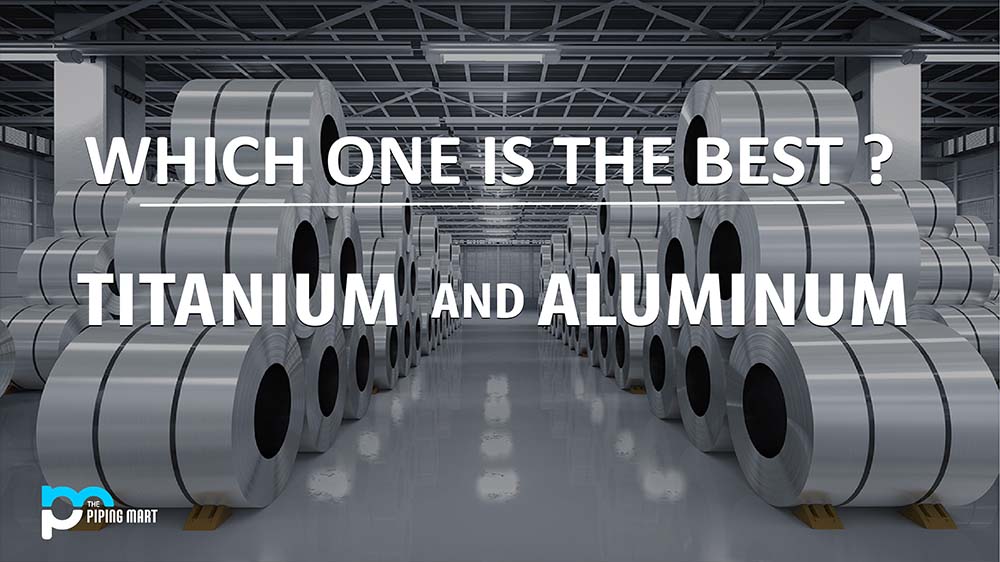Let’s Compare 17 Differences Between Titanium and Aluminum
When you think of the ideal material attributes for parts in the manufacturing industry, strength and lightweight immediately come to mind. In essence, designers automatically think of titanium and Aluminium in this situation. Interestingly, titanium and Aluminium check off other crucial boxes like superior heat tolerance and corrosion resistance. We will compare titanium and Aluminium using several attributes to help you find the best option for your project. They consist of the following:
-
Element Composition
The elemental composition is crucial in attempting to distinguish titanium from Aluminium. This is because specific components might not be necessary due to their reactivity with the environment or the additional properties they might offer to the metal. These qualities might include weight, corrosion resistance, and many others. Nitrogen, hydrogen, oxygen, carbon, iron, and nickel are among the several elements titanium is known to contain in contrast. Other elements may range in content from 0.013 and 0.5%, with titanium being the predominant element.
On the other hand, Aluminium comprises a wide range of elements, including silicon, zinc, magnesium, manganese, copper, iron, titanium, chromium, zirconium, and many more. Aluminum itself makes up the majority of the material.
-
Corrosion Resistance
Another characteristic that can be used to compare titanium and Aluminium is corrosion resistance. Aluminum and titanium both exhibit strong corrosion resistance qualities. However, one is more resilient than the other, making it the better option when corrosion resistance is a critical factor in a project.
Because titanium is inert, it has excellent corrosion resistance. Titanium is the most biocompatible metal and has a wide range of applications in the medical field because of its static nature. While Ti 6-4 alloys perform well in a saltwater environment and have excellent applicability in the marine industry, this application may be found in manufacturing surgical applications. On the other hand, aluminum alloys develop an oxide layer that prevents the material from reacting with corrosive substances. The corrosion of such alloys presently, however, is influenced by aqueous/atmospheric factors such as temperature, chemicals in the air, and chemical composition.
-
Electrical conductivity
A material’s capacity to permit the movement of electrons in response to a drop in potential is known as electrical conductivity. Copper is utilized as the benchmark for rating electrical conductivity when evaluating a material’s electrical conductivity.
When titanium’s conductivity was compared to copper’s, it showed roughly 3.1% of copper’s conductivity. Since titanium is a good conductor of electricity, it cannot be employed in applications where good conductivity is the primary consideration. Titanium can be a suitable resistor despite not being a good conductor. On the other hand, the conductivity of Aluminium is 64% of that of copper. This indicates that Aluminium is favored over titanium in applications requiring electrical conductivity.
-
Thermal Conductivity
A material’s capacity to transmit or conduct heat is known as its thermal conductivity. High thermal conductivity is required for a material to be a good radiator, whereas low thermal conductivity makes a substance a good insulator. The time rate of transfer through conduction through a unit thickness, across a unit of material, for a unit temperature gradient is the technical name for this phenomenon.
Compared to titanium, which has a thermal conductivity of 118 BTU/hr/ft2/°F (17.0 W/m-K), Aluminium has a high thermal conductivity of 1460 BTU/hr/ft2/°F (210 W/m-K). Since it is used in applications like heat exchangers, cookware, and heatsinks, it is given preference.
-
Melting point
The temperature at which a metal starts to change from a solid phase into a liquid phase is known as the melting point of that metal. The metal is in an equilibrium between its solid and liquid phases at this temperature. The material is easily formable and suitable for thermal applications once it reaches this temperature.
Titanium is a refractory metal because of its higher melting point of 1650–1670 °C (3000–3040 °F). On the other hand, Aluminium has a lower melting point than titanium, at 660.37 °C (1220.7 °F). As a result, titanium is more appropriate for applications requiring heat resistance.
-
Hardness
Hardness is the relative measure of a metal’s resistance to etching, denting, deformation, or scratching over its surface. Most of this can be accomplished using a device called an indenter machine. As a result, the indenter tool or machine reveals the value of the metal to ascertain its strength. Although pure Aluminium only has a Brinell hardness of 15 HB compared to titanium’s 70 HB, some aluminum alloys showed better hardness than titanium. AA7075 temper T7 & T6, AA6082 temper T5 & T6, and other examples include a few.
On the other hand, when damaged or dented, titanium deforms easily. This can be fixed since titanium creates a rigid surface by producing an oxide layer that withstands most penetration pressures. Titanium is the ideal option if hardness is a crucial requirement for the application.
-
Density
Both titanium and Aluminium are light in measurement, but for different reasons. Aluminum’s density (2712 kg/m3) is less than titanium’s (4500 kg/m3). Although titanium is around two-thirds heavier than Aluminium, Aluminium has a significantly lower density. Users of either metal will therefore require less titanium. The physical strength of Aluminium can be achieved using only a tiny amount of titanium. This is the rationale behind titanium usage in spacecraft and jet engines. It is well known that its strength and lightweight lower fuel costs.
As a result, titanium or Aluminium is a perfect fit depending on the application. For instance, titanium is utilized when the strength-to-weight ratio is a concern, whereas Aluminium is used when merely lightness is required.
-
Price
A standard piece of each metal, measuring one foot in length and a quarter-inch in diameter, is compared to determine how much cheaper titanium is than Aluminium. When compared, the aluminum rod was less expensive than the titanium rod, demonstrating that the two metals’ prices are different. In addition to being more expensive right away, titanium is costlier to manufacture since it is more complex to work with than Aluminium.
Another issue is that titanium is sensitive to work with and demands exceptional skill while grinding, bending, and welding. However, Aluminium is a better choice for most purposes because it is simple to work with and less expensive than other materials.
-
Durability
When a material is put through the rigors of routine operations, its durability is its capacity to continue functioning without requiring extensive repairs or maintenance. Aluminum and titanium are both solid materials that may be utilized for a longer time, without a doubt. When properly maintained, titanium is highly robust and sturdy, and its frames can last for decades without showing any signs of wear and tear.
Additionally, titanium can feel whippy when exposed to a high load like touring panniers and offers some good flex to help dampen the vibration of the road. However, Aluminium also demonstrates its toughness in challenging transportation settings, mainly when strength, safety, and longevity are crucial.
-
Machinability
A metal’s machinability score compares it to other metals to show how well it responds to stress from machining operations, including milling, turning, and stamping. The machining technique is based on the metal’s machinability score. CNC turning and milling are tried-and-true processes for making titanium and aluminum parts. They can be made in less than a day with +/-0.005 inch tolerances (0.13mm). Aluminum is a great option when speedy part production is needed because it is affordable and high-quality.
However, when it comes to geometrics, machining may be somewhat constrained because excessively complicated designs necessitate a different solution regardless of the material used. Machining waste is another aspect to consider when selecting a material for machining. Milling away extra material is, therefore, acceptable for cheap Aluminium but not optimal for expensive titanium. As a result, manufacturers frequently use Aluminium to create prototypes before switching to titanium to create items.
-
Formability
Aluminum is more malleable than titanium in terms of shaping. Aluminum can be easily formed into final products utilizing various techniques. Depending on the form and shape of the material, Aluminium can be cut using multiple methods.
While laser, plasma, or water jet can generate final sizes with precise forms and shapes, it can also be cut with various saw kinds. Aluminum is the ideal material to use when formability is essential to the success of a project, even though titanium is formable but not as formable as Aluminium.
-
Weldability
Both metals can be linked or welded together when it comes to welding, which is the capacity of a substance to be united. Aluminum or titanium, however, is more easily joined than the other.
Titanium welding, in contrast, necessitates more professionalism because it is consistently considered a specialty inside a specialty. Aluminum, on the other hand, is highly weldable and has a variety of uses. Aluminum will be a fantastic choice if weldability is one of the critical criteria for material selection.
-
Yield Strength
The highest stress at which a material starts to distort permanently is known as the material’s yield strength. Aluminum and titanium can be separated from one another using this characteristic. It is clear from comparisons that commercially pure titanium (> 99% Ti) is a low- to moderate-strength metal unsuitable for airplane structures or engines. It displays high-purity titanium’s yield strength, which is considered poor for severely loaded aerostructures and ranges from 170 MPa to roughly 480 MPa.
On the other hand, the yield strength of pure Aluminium ranges from 7 MPa to roughly 11 MPa, whereas aluminum alloys range from 200 MPa to 600 MPa.
-
Tensile strength
The peak (ultimate) of the engineering stress-strain curve corresponds to a metal’s tensile strength. When a material is exposed to tension, this is the most significant stress that may be endured. At room temperature, titanium and its alloys have an ultimate tensile strength that ranges from 230 MPa for the softest grade of commercially pure titanium to 1400 MPa for high-strength alloys.
Additionally, depending on grade and condition, the proof strengths of titanium range from about 170 MPa to 1100 MPa. However, compared to pure Aluminium, aluminum alloys are stronger. The tensile strength of pure Aluminium is 90 MPa and can reach above 690 MPa for some heat-treatable aluminum alloys.
-
Shear Strength
Shear strength measures a metal’s resistance to a shear load before the component fails in shear. Most of the time, this happens naturally on a plane in a direction parallel to the force applied. Depending on the alloy, titanium shear stress ranges from 40 to 45 MPa, while aluminum shear strength ranges from 85 to around 435 MPa. Therefore, some grades of Aluminium may be preferred over titanium if shear strength is one of the critical criteria for material selection.
-
Color
The hue of the substance plays a significant role in distinguishing it from Aluminium or setting it apart from titanium. This will assist in identifying the importance and preventing the use of the incorrect metal for your project. To be distinguished, Aluminium has a silvery-white look that, depending on the surface, can range in hue from silver to dull grey. For smooth surfaces, this appearance tends to be silver. On the other hand, titanium appears silvery and gets darker when exposed to light.
Applications
Both Aluminium and titanium are employed in a wide range of applications. These methods could set the two metals apart from one another. The following are examples of how titanium and Aluminium are used:
Titanium
Titanium can be used in various applications, such as reducing grain size in steel, acting as a deoxidizer, and lowering the carbon content of stainless steel. In the industrial area, it can be found practically everywhere, including:
- Coatings, additives, and colors (paints, toothpaste, paper, & plastic)
- Landing gear, firewalls, essential structural components, hydraulic system,
- Valves, process vessels, heat exchangers, tanks, the pulp and paper industry, ultrasonic welding, sputtering targets, and many other items fall within the industry category.
- Consumer & architectural (sporting goods, eyeglasses, bicycles, guns, rakes, laptop components, and many other items)
- Jewelry (for body piercing, watch, rings, many more) (for body piercing, watch, rings, and many more)
- Medical (dental implants, surgical equipment, and other related items)
Aluminum
Due to its remarkable ability to resist corrosion, Aluminium is frequently employed in various industries. Several different Aluminium alloys significantly enhance their mechanical qualities, especially when tempered. For instance, the most popular aluminum alloy used in beverage cans and foils varies from 92% to 99% aluminum. The primary uses of Aluminium include:
- Transportation (aircraft, railroads cars, bicycles, automobiles, trucks, marine vessels, spacecraft, and many more) (aircraft railways cars, bicycles, automobiles, trucks, marine vessels, spacecraft, and many more)
- Packaging (cans, frame, foils) (cans, frame, foils,)
- Architecture & Construction (windows, siding, roofing, doors, building wire, sheathing, and many more)
- applications related to electricity (motors, transformers, generators, conductor alloys, generators, and many more)
- household products (cooking utensils, furniture, and many more)
- Tools & Machinery (pipes, tools, processing equipment, and many more)

Pipingmart is B2B portal specializes in industrial, metal and piping products. Also, share latest information and news related to products, materials and different types grades to help business dealing in this industry.




